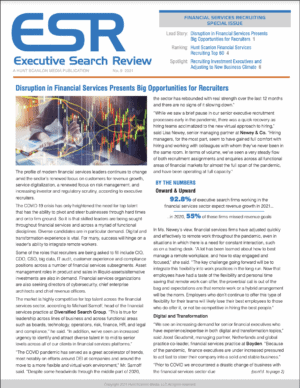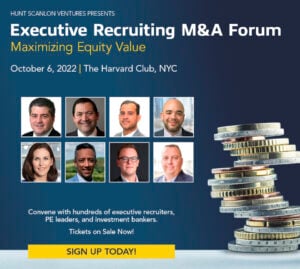Choosing the Right Leader in Financial Services

September 14, 2022 – Between 2003 and 2020, the average tenure for chief executive officers fell from 8.5 years to 3.7 years, according to a report in CEO magazine. Studies by PwC and the Conference Board have identified various factors that impact CEO tenure, including the complexity of the organizational operating environment due to ESG adoption, COVID considerations, rapid technology transfer, and changing global trade dynamics.
As such, it has become critical for boards in the financial services sector to stay ahead of such challenges and develop a well-structured CEO selection process, combined with an effective internal CEO candidate development and succession strategy,” says a new report, “CEO Selection in Financial Services,” from Canadian executive search firm Massey Henry.
A key consideration, say authors Michael Henry, managing partner, and John Sanders, senior partner, is to weigh the possibilities of both internal and external CEO prospects. “When organizations do not readily possess the internal talent needed for such a role, there is no other option but to look externally,” said the report. “Often, the absence of competent or ‘ready’ internal candidates is directly related to the efforts made by an organization in developing its senior executives internally, or towards sourcing potential CEO successors three to five years in advance of a CEO’s decision to retire.”
Research suggests that while internal candidates tend to have longer tenure and more effective leadership transition experiences, organizations often lack suitable successors within the organization. In many cases, a vastly different competency set is required for a new CEO in tandem with market and operational considerations, which internal candidates may not possess, says Massey Henry. For these reasons, research has shown that organizations select external candidates to replace incumbent CEOs more than 60 percent of the time.
Whether an internal or external candidate is ultimately selected, there are many important decisions that the board can make to mitigate risks around performance and/or tenure. Here are some key areas that Massey Henry says can make a significant difference in the outcome of a CEO selection process:
1. Establish the CEO search mandate
The board plays an important role in defining the objectives, guidelines, and process for CEO selection. The CEO mandate needs to be well crafted, and decisions must be made to ensure sound communication with key stakeholders regarding the recruitment process and/or the selection of an executive search firm, says the search firm. “Determining a consensus around the required experience, expertise, functional skills, and behavioral attributes of the future CEO will be especially important,” said the report. “Whether or not a formal CEO succession program is in place, the full board should be engaged in identifying the ideal CEO candidate profile.”
This discussion should be informed by the existing three to five year strategic plan, as well as the organization’s performance and competitive landscape. Given the
importance of strategy within a board’s duties, all relevant information should be transparent.
While these discussions typically involve the incumbent CEO in most organizations, the board should also consider the candidate profile independent of the current leader, said the Massey Henry report. Independent reflection will enable the board to openly discuss any expertise, experience, or leadership style
considerations required for the future CEO.
2. Determine the CEO selection committee
After establishing the ideal candidate profile for the next CEO, the board will need to determine the members of the CEO selection committee responsible for overseeing the recruitment process. “Whether a standing selection committee exists or not, the board chair should carefully review the composition of the selection committee to ensure that there is balance within the group,” said the report. “Bringing together an understanding of the organization and its culture, competitive marketplace, required functional expertise for the role, as well as key behavioral attributes are all important factors when choosing committee members for a CEO selection.”
Moreover, committee members need to demonstrate the capacity for balanced
decision making. There must be an understanding that some board members
will be better suited for a selection committee role than others. “This important but delicate reflection will require the chair to exercise their experience, insight, and discretion, while gracefully informing the board and organization about the decision,” said Massey Henry.
3. Stakeholder consultations
Conducting stakeholder consultations is an effective means of collecting valuable input to help shape a CEO selection mandate. Consultations are particularly effective in organizations that place a premium on consensus-driven leadership styles.
“Regardless of the organization’s style, it is wise to solicit input from stakeholders and influencers across the organization well ahead of the decision-making process,” said the report. “The complexity of today’s economic and geopolitical environment lends further importance to reflecting broadly about what skills and competencies are required for the next CEO to be successful.”
A bookend to the above activities should be a frank discussion of the overall process, timing, and the communication strategy to both internal and external stakeholders.
4. Stakeholder communications
An organizational change as significant as the selection of a new CEO requires a well planned and executed stakeholder communications strategy. Ultimately, a strong communications strategy should seek to achieve a balance between transparency and good corporate governance..
“The chair, the board, and incumbent CEO should work together to identify the
appropriate messaging and stakeholder communication plan prior to going to
market,” said the Massey Henry report. “Of course, certain circumstances will require specific communications to investors and regulators, but it is important to ensure that key stakeholders and influencers are made aware of ongoing developments.”
“The scope and content of the communications process will vary between
organizations, but the communication strategy should provide awareness about the CEO search and its context; outline the process, timetable, and desired outcomes; and discuss how stakeholders will be engaged during the search and onboarding process,” said the study.
5. Selecting an executive search firm
Proper due diligence is key whether engaging with a new or existing executive search partner. An engaged search partner should bring financial services sector expertise, relevant experience, and an established network of C-suite contacts, said Massey Henry.
 ‘Hunt Scanlon Financial Services Recruiting’ Special Issue
‘Hunt Scanlon Financial Services Recruiting’ Special Issue
Executive Search Review has just released its 2021 Financial Services Recruiting special issue newsletter! The profile of modern financial services leaders continues to change amid the sector’s renewed focus on customers for revenue growth, service digitalization, a renewed focus on risk management, and increasing investor and regulatory scrutiny, according to executive recruiters. The COVID-19 crisis has only heightened the need for top talent that has the ability to pivot and steer. businesses through hard times and onto firm ground. So it is that skilled leaders are being sought throughout financial services and across a myriad of functional
disciplines.
Hunt Scanlon presents its annual roundup of the 60 most prominent executive search firms serving the financial services sector. Click here and enjoy!
“While the above are fundamental to a successful search, the interpersonal skills required to collaborate and work with the board, internal senior executive leaders, and candidates will also be critical,” said the report. “In short, a balance of IQ and EQ enables search partners to provide competent and candid advice to internal senior leadership and to candidates within the context of the situation and organization. The ability to appreciate context, culture, and nuance should also be a prime consideration in the selection of a search partner.”
6. CEO compensation review
Early consideration and contingency planning regarding compensation will have significant benefits for the board and the respective committees that have input into compensation matters. A well-developed approach and philosophy will be necessary to ensure that the organization is prepared for finalist candidate discussions and negotiations, says Massey Henry. At times, fresh consideration of current compensation frameworks and potential alternative approaches is warranted.
These considerations should cover the following:
- Review internal vs. external compensation practices, with a focus on what is appropriate for the organization but in line with market practices Prepare for ‘keeping whole’ issues, such as STIP forfeitures, unvested LTIP, pension entitlements, and relocation expenses.
- Prepare for redlines in advance for instances where current programs in place might not meet finalist candidate expectations.
- Remember that compensation expectations are a business issue, not an affront to the selection committee or organization.
7. Assessment & Onboarding
Organizations need to be aware of the assessment methodologies and tools available, as well as the strengths and weaknesses of different approaches when evaluating candidates. It is important to remember that assessment methodologies used to evaluate other levels within an organization may not be appropriate in a CEO selection process.
Related: Retaining Your Employees During the Great Resignation
“The most significant decision to be made regarding testing is the leadership attributes and behaviors the assessment should focus on,” said the Massey Henry report. “At the CEO level, we suggest that assessment results should be paired with an in-depth debrief session conducted by a qualified assessment practitioner.
The debrief session provides the candidate with assessment results, but also creates an opportunity for the assessment practitioner to provide further input into the candidate’s relative strengths and weaknesses.”
Onboarding discussions and planning need to occur early in the selection process. Failure to think through the immediate onboarding process and outcome for the new CEO’s first year substantially increases transition and integration risks.
One of the first considerations should be the identification of a potential
“mentor” for the new CEO; this individual would provide support and guidance to
the successful candidate. This relationship would be distinct from the formal
relationship that a CEO has with the chair of the board—the mentor relationship is
designed to help the new CEO navigate situations, people, and organizational
culture during the critical first year.
“It is best to identify a few potential mentors early in the process given that the
background, personality, and behavioral attributes of the successful candidate
would be unknown at the outset of a search process,” said the report. “Beyond the identification of mentors, the selection committee and the board at large should also determine some of the key milestones for the first 90 days and the balance of the year. These milestones typically involve stakeholder meetings, pre-planned strategy sessions, and of course, AGMs. These conversations also help inform the scope and extent of stakeholder communications at the outset of the search, as well during the onboarding period.”
“Based on the many CEO selection engagements our firm has led in recent
years…it is critical for boards to implement a structured process that regularly reviews the CEO succession planning process,” said Massey Henry. “They must also understand the key considerations regarding the decision to execute an internal or external CEO selection process. Ultimately, financial services organizations that are deliberate in their approach to CEO selection will have a competitive advantage when it comes to identifying and onboarding their next CEO.”
To read the full report click here.
Related: Hiring Top Talent in Unprecedented Times
Contributed by Scott A. Scanlon, Editor-in-Chief; Dale M. Zupsansky, Managing Editor; and Stephen Sawicki, Managing Editor – Hunt Scanlon Media













